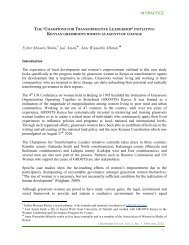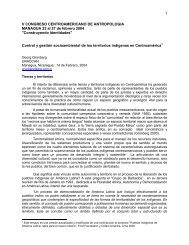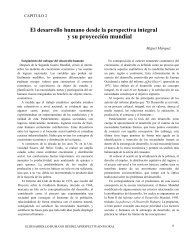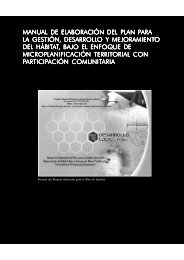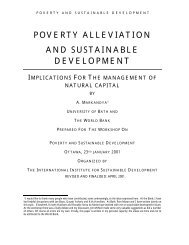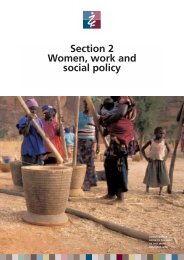The Cluster Initiative Greenbook
The Cluster Initiative Greenbook
The Cluster Initiative Greenbook
You also want an ePaper? Increase the reach of your titles
YUMPU automatically turns print PDFs into web optimized ePapers that Google loves.
Nor is there any significant difference if they are grouped by main financing source.<br />
Government-financed CIs do not perform significantly better or worse than those<br />
financed primarily by industry or equally by industry and government.<br />
<strong>The</strong> only pattern emerging from the data is that the few CIs initiated primarily by the<br />
university sector have performed somewhat better in terms of improving ties between<br />
industry and academia, which is not surprising.<br />
CI has increased int'l competitiveness<br />
CI has attracted new firms to area<br />
+.19 +.18<br />
CI competed to get gov't financing<br />
Not sig.<br />
Choice of cluster based on gov't<br />
research<br />
Not sig.<br />
CI competed to get gov't financing<br />
Choice of cluster based on gov't<br />
research<br />
Figure 50<br />
Relationship between<br />
performance and early<br />
government intervension<br />
Source: GCIS 2003<br />
Early government intervention<br />
<strong>The</strong> findings are mixed regarding government actions on an initial stage to ensure the<br />
success of a CI (see Figure 50 above). On the one hand, those CIs that went through<br />
a process of competing with other CIs to get government financing tend to perform<br />
better in terms of competitiveness, but not in terms of attracting new firms. On the<br />
other hand, if government bases its choice of which cluster to support with a CI on<br />
research identifying “attractive” industry sectors, this is related to better performance<br />
in attracting new firms, but not to increasing competitiveness.<br />
<strong>The</strong>re are other types of government intervention, which have no significant effect<br />
at all. If the government decides from the start which companies to involve in the CI<br />
– instead of leaving this choice to the industry or having the CI open to all – there is no<br />
measurable effect (not shown in graph).<br />
Picking the right members<br />
Limiting the scope of the CI by aiming for a certain subgroup within the cluster as<br />
members does not help performance. (See Figure 51 below.) CIs with most members<br />
within one hour’s travel distance, CIs with members on a particular level in the value<br />
chain and not their suppliers or customers, CIs avoiding having direct competitors as<br />
members, and CIs aiming at large companies rather than small ones have not per-<br />
CI has attracted new firms to area<br />
Not sig. Not sig. Not sig. Not sig.<br />
Most parties within 1 hr<br />
travel distance<br />
Single level in value chain<br />
No direct competitors as<br />
members<br />
Large companies, not<br />
small<br />
-.26<br />
Domestic companies, not<br />
foreign owned<br />
Figure 51<br />
Relationship between<br />
membership scope and<br />
performance in attracting new<br />
firms<br />
Source: GCIS 2003<br />
<strong>The</strong> <strong>Cluster</strong> <strong>Initiative</strong> <strong>Greenbook</strong> • 49




